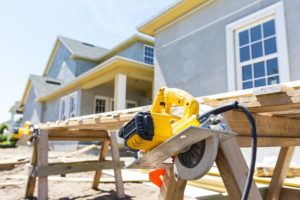At this time of year, it’s always fun to look ahead to what might be; in our case, what new houses might look like in the future.
Unfortunately, no one has a crystal ball that can predict exactly how much bigger or smaller newly constructed houses will be or what will be inside. But the folks at Porch, a website that connects homeowners with professional repairmen and remodelers, have taken a shot at it.
They analyzed current and projected trends to predict what houses of the future will be like as far off as 2036. But for our purposes here, we’ll concentrate on what they think new houses will look like in 2026, just eight short years from now.
Some of Porch’s predictions seem to be off the mark, perhaps by a wide margin. Others are quite surprising. Despite the current trend for building smaller houses to combat the affordability crisis, for example, Porch boldly suggests that houses will grow larger, not slim down further, with more bedrooms and baths.
According to the latest data from the U.S. Census Bureau, the average house in last year’s third quarter declined to 2,495 square feet. And the National Association of Home Builders says house sizes have been falling for the last three years as builders add more entry-level houses to their product mix.
But the Porch report asks: “Why have less when you could have more?”
Using Census Bureau data from 2016 as its baseline, Porch reckons that houses will be more than 200 square feet larger on average in 2026. That’s the equivalent of two rooms, 10-by-10 feet each.
All this will happen, Porch prognosticators suggest, on smaller and smaller lots, from an average of nearly 31,000 square feet in 2016 to 28,000 in 2026 and 2,050 in 2036.
One of the trends that is driving up house sizes is the number of bedrooms and baths.
Houses with two or fewer bedrooms are expected to continue to decline to only about 10 percent of all new construction in eight years, while those with three bedrooms will fall to about 39 percent. Even at that, three-bedroom abodes will still be predominant.
The rest of the new houses built in 2026 will be four bedrooms or more, Porch predicts. Nearly 37 percent of all new houses will have four bedrooms by 2026. But those with five sleeping rooms will account for more than 14 percent, a 3.6 percentage point increase from 2016.
Meanwhile, houses with a single bathroom are heading for oblivion. Two baths will continue to dominate, but they, too, will be fewer and fewer, according to Porch’s predictions. In 2026, only half of the newly built houses will have two bathrooms. The rest will have either three or four, but mostly three.
Garages will be larger in the future, Porch suggests. Only 7 percent of new homes in 2026 will have a one-car garage, while 60 percent will have room for two vehicles and 25 percent will hold three. About 8 percent won’t have a garage at all.
After a brief increase over the last decade, the number of single-story homes will decline, but just slightly over the next eight years, the report indicates. At the same time, two-story production will grow, but again, ever so slightly.
What’s all this going to cost? Porch weighs in on that, too. In 2016, it says, the average price for a 2,600-square-foot house was $198,000. In 2026, the average cost of a slightly larger 2,700-square-foot house will be $252,000, a jump of $54,000.
As Porch sees it, decks are on their way out, replaced by patios and the iconic piece of American architecture, the front porch. Ditto for fireplaces, which won’t be found in 60 percent of new construction in 2026. (Here, the report considers a fireplace as a source of heat, not for its romantic quality, which is why most people want them.)
Still, there’s more to what goes into a home than space and rooms, the report notes. “The house of the future could be more energy efficient and durable and incorporate exciting advances in automated technology.”
Along those lines, it points out, giant home builder Lennar, already pre-wiring its houses for Wi-Fi compatibility, has taken smart home technology to the next level by building Alexa, Amazon’s smart digital assistant, into all its new production. And California has mandated that solar panels be placed on every new house built within its borders.
(Next week: Future Financing)
(Lew Sichelman has been covering real estate for more than 50 years. He is a regular contributor to numerous shelter magazines and housing and housing-finance industry publications. Readers can contact him at lsichelman@aol.com.)

